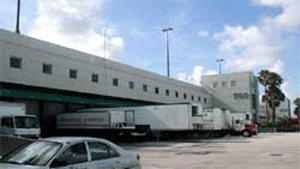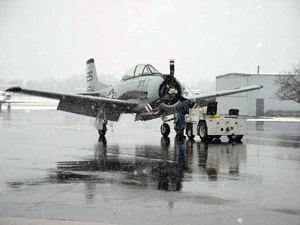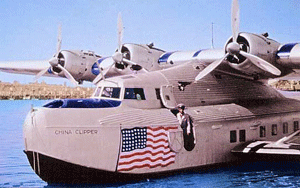Changes Flowering
 Miami
International Airport handles 88 percent of the fresh-cut flowers
that enter the USA, but to hear local transportation people talk,
things are getting tougher for airlines, importers and truckers
who make their living moving flowers through the gateway. Miami
International Airport handles 88 percent of the fresh-cut flowers
that enter the USA, but to hear local transportation people talk,
things are getting tougher for airlines, importers and truckers
who make their living moving flowers through the gateway.
The future that once seemed great
is anything but a bed of roses, according to some.
Right now the $7.2 billion annual
fresh-cut flower business in USA is blooming, (more than 2 billion
was spent one week ago on Mother’s Day), but discounters and
an over abundance of product worldwide, plus elevated costs (fuel
etc.) are exerting some downward pressure and threaten future industry
profits.
While every cost associated with fresh
flowers keeps going up, sales seem to have flattened out in terms
of building business, leaving the passing of costs along to the
consumer nothing more than a pipe dream.
Add to airport and industry woes is
the move (or rush really) to sell and distribute fresh flowers outside
the accepted traditional lanes.
Now many big flower people are bracing
for business in a whole new way.
Many think that everything between
the farmer and retailer is up for grabs sending a clear message
to MIA that relies upon its flower business to be in the cargo business,
and the airlines as well.
Just as has happened in so many other
parts of air cargo the middlemen in flowers are being pressured
to prove their worth.
''Looking 10 years down the line,
the grower and consumer are going to stay, and everything in the
middle is subject to change,'' Gustavo Moreno, a flower wholesaler
told The Miami Herald.
''Ten years ago, you didn't have a
national supermarket chain,'' involved in the flower business, Moreno
said, referring to availability of fresh cut flowers today in places
like Wal Mart and elsewhere.
"Today instead of 150 buyers
that could buy significant volumes, you have 15 buyers that control
the market.
“They can put tremendous pressure
on prices," he told The Herald.
Change for the once predictable flower
trade in America will be further impacted as new sources for the
product move into the market.
Of course Netherlands is always a
factor as are Colombia and Ecuador, but on the horizon are growers
in Africa from places such as Kenya and Ethiopia eager to develop
their flower export industries.
Meantime with many buildings on and
off-airport that are little more than giant reefers under a roof,
no one doubts that MIA will continue its perishables pre-eminence
for some time to come.
But change is clearly underway. |
In
America where RFD used to mean “rural
free delivery” meaning the mails, today RFD stands for Chicago/Rockford
International Airport.
Cargo tonnage like you can’t
imagine, where you least expect it apparently is an every day deal
at RFD.
According to the Business Section
of last Friday's Rockford Register Star:
“Business
has shown strong growth in recent years in its air cargo activity
with UPS’ second-largest hub being based there.
“In
2002, 1.26 billion tons of cargo moved through the airport.
“That increased to 1.35 billion tons in
2005, largely because of UPS.”
The thing
that first caught our eye was the writer describing Emery Air hiring
workers at RFD.
“Emery Air provides
a variety of aviation-related services at the airport from aircraft
maintenance and management to ground services for passenger airlines
and UPS.
 “The
company now employs around 140 people and has been growing as airport
traffic increased.” “The
company now employs around 140 people and has been growing as airport
traffic increased.”
Emery Air we learn
has been a full service FBO and other things at RFD since the 1950’s
servicing all kinds of flights including this restored T-2 WW 11
trainer that stopped by in the snow one winter (www.emeryair.net).
The cargo numbers based on Rockford passenger
movement of about 150,000 souls last year must be millions of pounds,
not billions of tons.
An airport moving 1.35
billion tons of UPS cargo with ground and aircraft maintenance provided
by Emery, we imagine proves one thing.
Always
expect the unexpected.
One more point.
Chicago/Rockford located about 70 miles from Chicago
is like calling Philadelphia Airport Newark/Philadelphia, although
everyone knows EWR is really a New York airline destination.
Stay tuned for further amplification.
(Geoffrey) |

Sixty years ago Pan Am spent $417,000 to
purchase “The China Clipper” from The Martin Company
of Middle River, Maryland launching long distance air travel across
the Pacific from the west coast of the U.S. as modern long distance
air travel was transformed.
Today Emirates Airline has placed more than
one third of all the orders amongst passenger airlines for the
A380 long distance jumbo jet that will transform international
travel for the new century.
Quote from Times of London Sunday
May 21:
“Emirates Airline is doubling its fleet
of Boeing and Airbus jets, setting it on a flight path to overtake
British Airways as the world’s biggest long-haul carrier
by 2012.”
Maybe.
But our view is nothing will diminish a world
airline ranking faster than that airline itself.
Recent carping by a BA executive about U.S.
carriers (UAL in particular) getting a free pass to grow while
being protected by bankruptcy laws was particularly clawing to
anyone old enough to recall the thinly veiled British bailout
of BA during the 1980’s.
Meantime all global airlines are putting on
long-range aircraft to fly point to point between lucrative 12
to 14 hour destinations as fast as possible.
The model invented by KLM in 1927 and Pan Am,
Lufthansa, Air France, Sabena, Varig and BOAC after that, has
been joined by Singapore, and Continental in modern times as the
way to fly now.
One thing for certain, things ain’t what
they used to be, and maybe never were.
(GDA)
|
 Thai
Airways that has affected a 77% turn around in its financial fortunes
as tourism ramps up across Southeast Asia, is not wasting any
time cost cutting wherever it can. Thai
Airways that has affected a 77% turn around in its financial fortunes
as tourism ramps up across Southeast Asia, is not wasting any
time cost cutting wherever it can.
Latest icons of that airline to get the axe are four remaining
MD11s in the fleet including two that had been painted in snazzy
new colors.
All of this has caused some to speculate that the decision to
dump the MD11’s was sudden. Sources say that two of the
aircraft are bound for UPS.
|
Got an airplane and a dream?
Wilkes
Barre Pennsylvania (USA) regional business owners are organized
in an effort to have air cargo service brought back to the Wilkes-Barre/Scranton
International Airport.
“Funeral directors,
florists and others, say having to pick up or ship at airports in
Philadelphia, Newark or Syracuse is costly and time-consuming,”
the WB Times Ledger said.
“It
really is an inconvenience for us and our clients,” said Lackawanna
County funeral director Timothy Kramer, spokesman for the Air Cargo
Coalition.
“It costs more money and
that cost is passed on to the consumer.
“We’re
told that the airlines don’t bring in jets that are big enough
to carry cargo,” Kramer said. “We’re trying to
put together some numbers that show the impact on the area.
“Everybody’s paying a higher toll
for everything because of this.”
Wilkes
Barre/Scranton Airport it should be noted spent some three million
USD a couple years ago to install a separate ramp for air cargo.
Air Cargo Coalition, P.O. Box 4053, Scranton
PA 18505. E-mail: tkundertaker55@yahoo.com |
|



